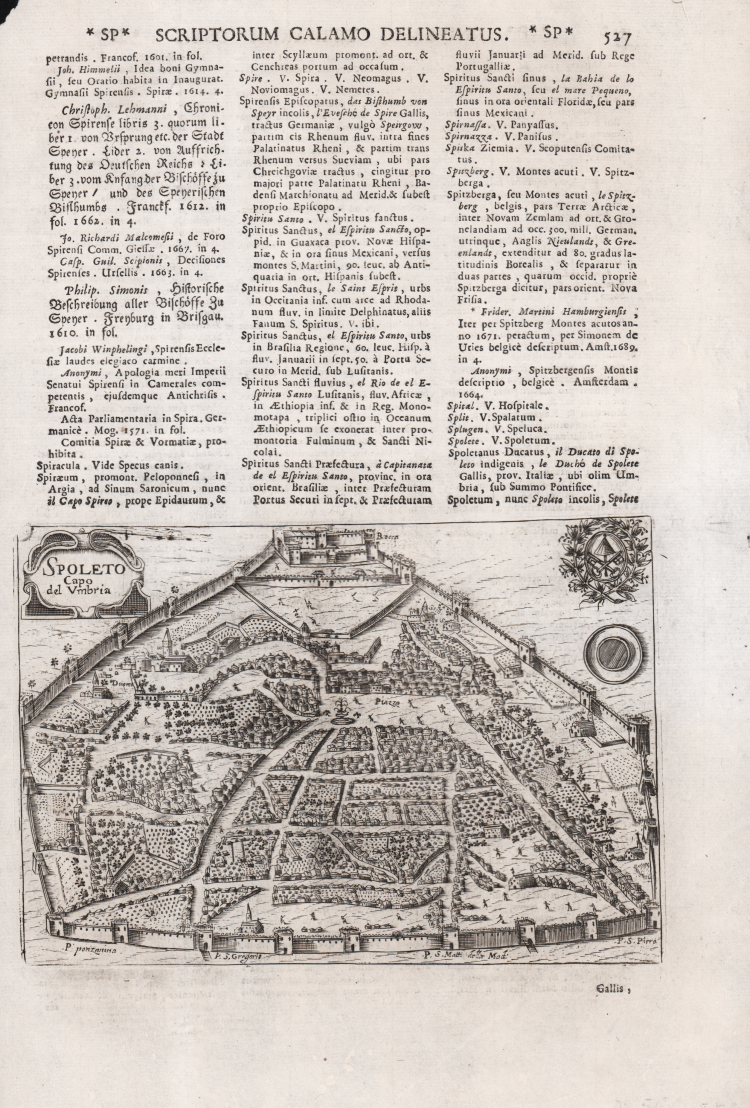



| Reference: | CO-671 |
| Author | Pietro BERTELLI |
| Year: | 1713 |
| Zone: | Spoleto |
| Printed: | Venice |
| Measures: | 185 x 130 mm |


| Reference: | CO-671 |
| Author | Pietro BERTELLI |
| Year: | 1713 |
| Zone: | Spoleto |
| Printed: | Venice |
| Measures: | 185 x 130 mm |
Pianta della città preparata per il celebre "Theatrum urbium Italicarum", raccolta di vedute urbane della penisola pubblicata per la prima volta a Venezia nel 1599. La prima edizione comprendeva cinquantanove tavole con piante e vedute prospettiche adespote, di mano di più incisori, accompagnate da una descrizione latina, che uscirono isolatamente stampate a Venezia (forse nella bottega di Francesco Bertelli), ma con la dedica datata sempre da Padova. Ignoto è l'autore del testo, anche se è stato supposto che ne sia autore lo stesso Bertelli.
L'edizione, comunemente considerata seconda, uscì a Vicenza, nel 1616, per i tipi di Domenico Amadio, con titolo italiano di "Teatro delle città d'Italia", con l'aggiunta di alcune tavole (67 anziché 59), ma fu preceduta da una edizione non datata costituita dai rami senza testo.
“L’ultima raccolta di cartografia urbana del XVI secolo, venne stampata da Pietro Bertelli (1571 circa - 1621) nel 1599 Pietro era editore, incisore e tipografo, figlio di Ferrando Bertelli, lavoro a Padova, nella Libreria all’insegna dell’Angelo, a Venezia e a Vicenza. Come incisore, nel 1589 collaboro ad alcune tavole dell’opera Diversarum nationum habitus… composta da 106 stampe, edita in collaborazione con Alciato Alciati. Per le Vite degli imperatori de’ Turchi con le loro effigie intagliate in rame per i tipi di Giorgio Greco, edita a Vicenza nel 1599, Bertelli incise quindici ritratti. Nello stesso anno usci il Theatrum Urbium Italicarum, serie di 59 tavole con vedute e piante accompagnate da descrizione latina, eseguite da più incisori, poi ristampata, accresciuta, anche con il titolo italiano Teatro delle città d’Italia, per i tipi di Domenico Amadio. Alla sua morte, l’attività prosegui con suo figlio Francesco, anch’egli tipografo, incisore e editore. La sua marca tipografica era un angelo in piedi con le ali spiegate, l’avambraccio destro puntato verso l’alto con l’indice al cielo e un giglio nella mano sinistra. Il Teatro delle città d’Italia venne più volte ristampato e implementato da Francesco nel corso del secolo successivo” (cfr. S. Bifolco, Città e Fortezze Principali del Mondo. Le prime raccolte italiane di cartografia urbana e gli isolari del XVI secolo in “Cartografia e topografia italiana del XVI secolo” p. 133).
Questo esemplare è tratto dall'opera Universus terrarum orbis scriptorum calamo delineatus ... qui de Europae, Asiae, Africae, & Americae regnis, provinciis, populis, civitatibus.... pubblicata a Padova nel 1713, presso Matteo Cadorin, da Raffaello Savonarola, sotto lo pseudonimo di Lasor a Varea (o Varela).
L'opera era una sorta di enciclopedia che conteneva notizie sulle varie località del mondo disposte in ordine alfabetico, arricchita da mappe e vedute di tutto il mondo che appartengono a celebri raccolte cartografiche del passato – Bertelli, Valegio, Camocio, Bonifacio, Nelli, Magini e altri – del quale probabilmente l’editore Cadorin era in possesso delle matrici originali.
Acquaforte, in ottimo stato di conservazione.
Pietro BERTELLI (Padova 1571 - 1621)
|
Bertelli family represents the largest group of publishers, engravers, cartographers and merchants of prints of the sixteenth century. Ferrando Bertelli was the most productive, active between 1570, the 1560th, but maps of the last quarter of the century are known by the names of Andrea, Donato, Lucca, Nicholas and Peter. This was mainly active in Padua, where he led a workshop in letterpress and engravings. The earliest records show the asset at the date of 1589 as an engraver of several plates for an edition entitled Diversarum nationum habitus which was published in collaboration with Alciato Alciati. Pietro Bertelli had a library in Padua "the banner of the Angel". At his death the business was inherited by his son Francis. Perhaps son Ferrando Bertelli. He was active mainly in Padua, where he led a workshop in letterpress and engravings. The earliest records show the asset at the date of 1589 as an engraver of several plates for an edition entitled Diversarum nationum habitus which was published in collaboration with Alciato Alciati. Pietro Bertelli had a library in Padua "the banner of the Angel". At his death the business was inherited by his son Francis. Bibliography: Valerio, Cartographers Veneti, p. 149.
|
Pietro BERTELLI (Padova 1571 - 1621)
|
Bertelli family represents the largest group of publishers, engravers, cartographers and merchants of prints of the sixteenth century. Ferrando Bertelli was the most productive, active between 1570, the 1560th, but maps of the last quarter of the century are known by the names of Andrea, Donato, Lucca, Nicholas and Peter. This was mainly active in Padua, where he led a workshop in letterpress and engravings. The earliest records show the asset at the date of 1589 as an engraver of several plates for an edition entitled Diversarum nationum habitus which was published in collaboration with Alciato Alciati. Pietro Bertelli had a library in Padua "the banner of the Angel". At his death the business was inherited by his son Francis. Perhaps son Ferrando Bertelli. He was active mainly in Padua, where he led a workshop in letterpress and engravings. The earliest records show the asset at the date of 1589 as an engraver of several plates for an edition entitled Diversarum nationum habitus which was published in collaboration with Alciato Alciati. Pietro Bertelli had a library in Padua "the banner of the Angel". At his death the business was inherited by his son Francis. Bibliography: Valerio, Cartographers Veneti, p. 149.
|